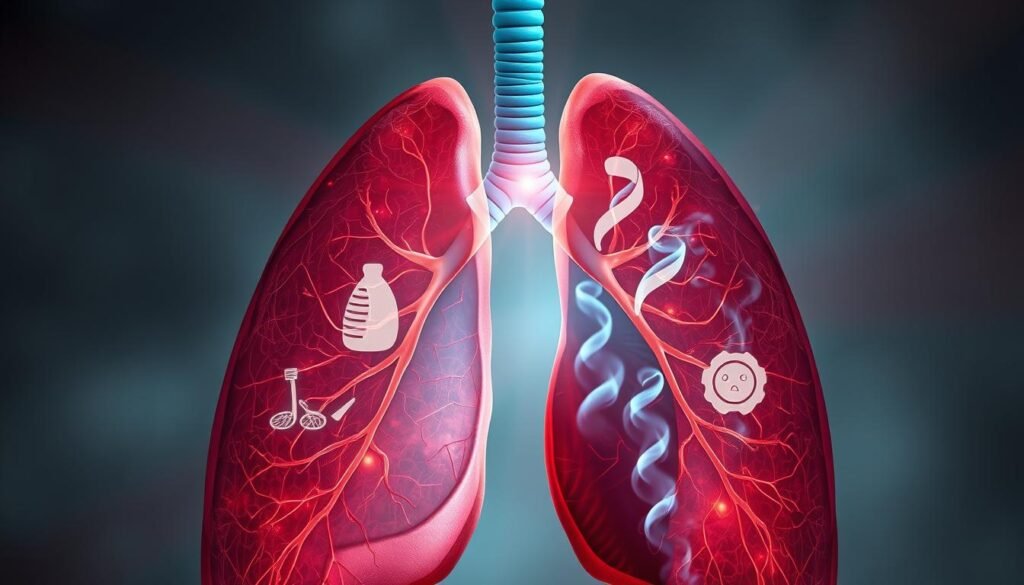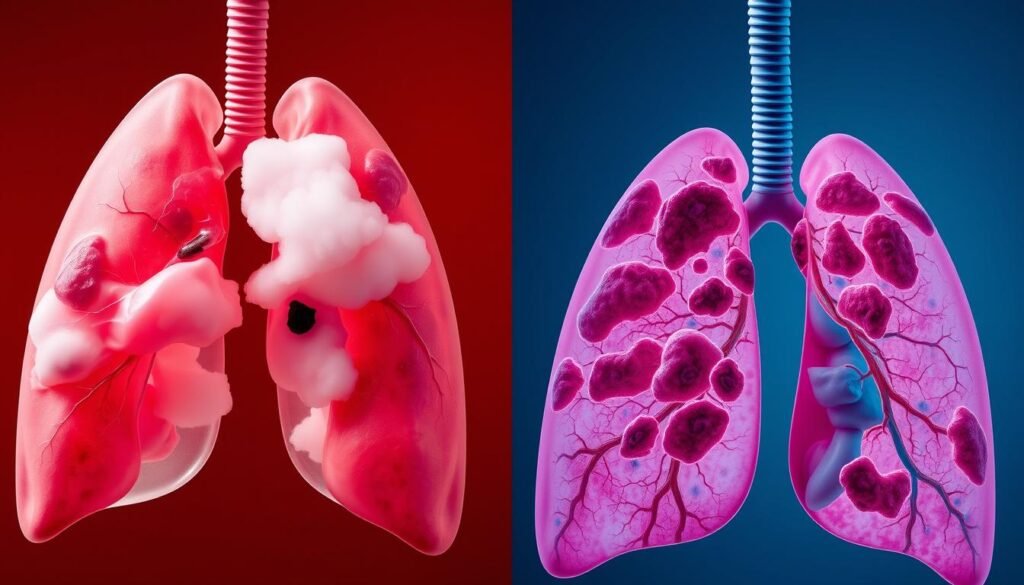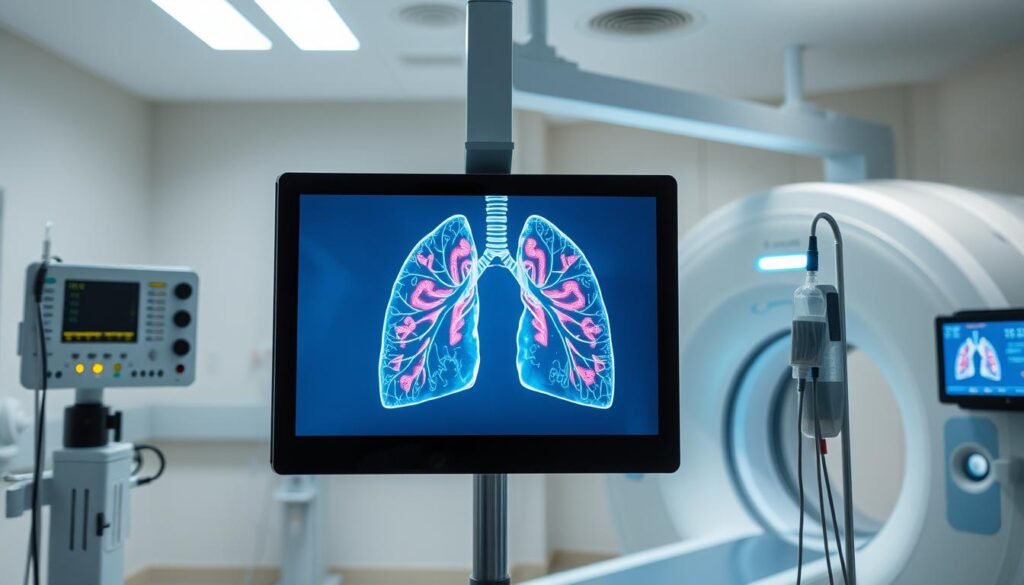Did you know over half of those with lung cancer get pneumonia too? This fact highlights the need to understand how lung cancer and pneumonia are connected. People fighting lung cancer are more likely to catch respiratory infections. It’s crucial to spot symptoms early. Doing so can greatly impact treatment success.
Both conditions often cause persistent coughing, feeling tired, and chest pain. In our detailed look, we explore how symptoms of lung cancer and pneumonia overlap. This knowledge helps in making better choices for prevention and treatment. Actions like getting vaccinated and living healthily strengthen immunity against these diseases. For more information, check out WebMD’s guide on lung cancer.
Key Takeaways
- Over half of lung cancer patients develop pneumonia due to weakened immune systems.
- Recognizing the symptoms of lung cancer and pneumonia early is crucial for treatment.
- Pneumonia can arise from various causes, including viruses, bacteria, and fungi.
- Preventive measures are essential for lung cancer patients to reduce pneumonia risks.
- Diagnostic tests play a key role in differentiating between lung cancer and pneumonia.
Pneumonia: A Common Concern for Lung Cancer Patients
Pneumonia is a big health risk for those with lung cancer. They often deal with issues from both the cancer and its treatments. It’s key to know how these affect each other for better care.
Link Between Lung Cancer and Pneumonia
About 10% of hospital visits for cancer patients are made worse by pneumonia. This issue is common in those with lung cancer. Sadly, 30% of these patients do not survive their stay in the hospital. This shows how serious pneumonia can be for them. Patients with blood cancers face an even higher risk of getting pneumonia.
Impact of Weakened Immune System
Having a weak immune system makes you more likely to catch infections like pneumonia. Cancer treatments, such as chemotherapy, can make this worse. Certain factors, like low scores on the Palliative Performance Scale, specific types of cancer, and low lymphocyte counts, raise the risk even more. Spotting these factors early is vital for helping patients sooner.
| Prognostic Factors | Odds Ratio (OR) | Confidence Interval (CI) |
|---|---|---|
| Palliative Performance Scale (PPS) ≤ 30 | 8.47 | 3.47–20.66 |
| PPS 40–50% | 2.79 | 1.34–5.81 |
| Percentage of lymphocytes ≤ 8.0% | 2.10 | 1.08–4.08 |
| Pulse oximetry ≤ 90% | 2.01 | 1.04–3.87 |
This shows that lung cancer and pneumonia together create a big problem. We need to act fast to strengthen the immune system. This can help lower the risk of pneumonia for these patients.
What is Lung Cancer?
Lung cancer is a major health issue caused by uncontrollable abnormal cell growth in the lungs. It’s important to know the types of lung cancer for prevention and treatment. The main types are non-small cell lung cancer (NSCLC) and small cell lung cancer (SCLC). NSCLC accounts for 80% to 85% of cases. SCLC is less common but grows more quickly and is strongly linked to smoking.
Overview of Lung Cancer Types
The prognosis and treatment of lung cancer types vary. NSCLC is divided into subtypes like adenocarcinoma, squamous cell carcinoma, and large cell carcinoma. Each has unique traits and responds differently to treatment.
Causes and Risk Factors
Smoking is the main cause of lung cancer, responsible for about 85% of cases. But, environmental factors like asbestos, radon, or air pollution also pose risks. These hazards can significantly raise the chances of developing lung disease.
There are other risk factors for lung cancer too. A family history of the disease, past chest radiation treatment, and chronic lung diseases like COPD matter. High-risk individuals should go for regular checks and take preventive steps.
Studies show lung cancer can make pneumonia more likely. Roughly 50% to 70% of lung cancer patients might also get pneumonia. Treatments like chemotherapy and radiation can weaken immunity, making infections easier to catch. For an in-depth study on pneumonia and lung cancer, click here.
Understanding Pneumonia Symptoms
Pneumonia is a big health issue, especially for people with weak immune systems. This includes those who have lung cancer. It’s key to know the different types of pneumonia and the symptoms they bring. This helps catch it early and manage it well.
Types of Pneumonia: Bacterial, Viral, and Fungal
Pneumonia comes in several types, such as bacterial, viral, and fungal. Each one attacks the lungs in its own way:
- Bacterial Pneumonia: This kind usually comes from bacteria, like Streptococcus pneumoniae. It spreads through the air we breathe. Taking antibiotics right away is often needed.
- Viral Pneumonia: Caused by viruses like the flu or RSV. Its symptoms are similar to the flu, making it hard to tell apart.
- Fungal Pneumonia: This is rare and mostly affects people with low immunity. It comes from certain fungi in the environment.
Common Symptoms of Pneumonia
The symptoms of pneumonia depend on what type you have and how severe it is. Common symptoms include:
- Cough, which may bring up mucus
- Fever and chills
- Having trouble breathing or feeling short of breath
- Feeling very tired and unwell
Spotting these symptoms is crucial. This is because they are similar to lung cancer symptoms. People with lung cancer have a high risk of getting pneumonia. About 50 to 70 percent might get it during their treatment. The risk goes up with age, other health issues, and being around pollution. For more info on how pneumonia and lung cancer are connected, click here.
| Pneumonia Type | Common Causes | Typical Symptoms |
|---|---|---|
| Bacterial | Streptococcus pneumoniae | Cough, fever, chest pain |
| Viral | Influenza, RSV | Cough, chills, fatigue |
| Fungal | Environmental fungi | Cough, difficulty breathing |
Symptoms of Lung Cancer
Knowing lung cancer symptoms is key for catching it early. It often goes unnoticed at first, revealing itself slowly. Spotting the signs early means getting help sooner.
Common Indicators of Lung Cancer
Watch out for these lung cancer signs:
- A chronic cough lasting at least eight weeks.
- Coughing up blood, even in minor amounts.
- Shortness of breath, which may occur during usual activities.
- Hoarseness possibly due to chronic cough or tumor pressure on the vocal cords.
- Chest pain that may worsen with deep breathing or coughing.
- Unexplained weight loss and persistent fatigue.
- Frequent respiratory infections such as bronchitis or pneumonia.
Advanced Symptoms to Watch For
More severe symptoms appear as lung cancer gets worse, such as:
- Bone pain from metastatic disease.
- Changes in the nervous system, hinting at tumor spread.
- Swollen lymph nodes indicating more cancer progression.
- Specific syndromes like Horner syndrome, linked to Pancoast tumors.
Understanding these lung cancer symptoms can catch it early. This improves chances for effective treatment. Notice any health changes? Talk to a doctor soon, especially if you’re at risk.

Lung Cancer with Pneumonia: How They Overlap
Lung cancer and pneumonia overlap, causing challenges in diagnosis and treatment. Both have symptoms like shortness of breath, persistent cough, and chest pain. This can confuse patients and doctors, making it hard to understand the health situation.
Research shows that up to 70% of lung cancer patients may get pneumonia. This shows how important it is to watch for lung infections in lung cancer cases. Also, people who’ve had pneumonia are three times more likely to develop lung cancer.
Conditions like Chronic Obstructive Pulmonary Disease (COPD) make things more complicated. Smokers with COPD are at a much higher risk of getting lung cancer. This shows why it’s important to protect those at high risk.
Chronic inflammation is linked to cancer growth. Inflammation in the lungs can lead to cancer. Respiratory infections can cause inflammation, which might help cancer grow.
The U.S. Preventive Services Task Force advises yearly lung cancer screenings for 50 to 80-year-olds who smoked a lot. This is vital due to the high rate of lung cancer and the serious impact of pneumonia. Early detection improves chances of a good outcome.
| Condition | Overlap with Lung Cancer | Risk Factors |
|---|---|---|
| Pneumonia | Common symptoms: cough, shortness of breath, chest pain | Increases lung cancer risk by three times |
| COPD | Contributes to lung cancer susceptibility | Twice the risk for non-smokers, five times for smokers |
| Chronic Inflammation | Promotes tumor microenvironment | Linked to infections and environmental exposure |
Understanding how lung cancer and pneumonia overlap is key to better treatment and health management. Ongoing research and raising public awareness are crucial in tackling these combined health issues.
How to Differentiate Between Lung Cancer and Pneumonia
Understanding the symptoms is key when telling lung cancer and pneumonia apart. Both conditions affect the lungs but show different symptoms. Lung cancer symptoms typically appear slowly and may not be noticed early. Pneumonia symptoms are more sudden, prompting the need for quick medical help.
Key Differences in Symptoms
Different symptoms help doctors identify each condition. Here are some common signs:
- Cough: Lung cancer might cause a lingering, dry cough. Pneumonia usually comes with a cough that brings up mucus.
- Breathing Difficulties: Trouble breathing is common in both, but it gets worse quickly with pneumonia.
- Chest Pain: Chest pain from lung cancer tends to be dull and steady. With pneumonia, the pain is sharp during coughs or deep breaths.
Diagnostic Methods for Each Condition
Different tests help diagnose lung cancer and pneumonia. Here’s a summary:
| Condition | Diagnostic Methods |
|---|---|
| Lung Cancer | Chest X-ray, CT scans, biopsy, and sputum analysis. |
| Pneumonia | Chest X-ray, sputum culture, blood tests, and physical examinations. |
It’s crucial to manage long-term lung diseases like COPD well. For more details on identifying lung cancer versus pneumonia, see the link provided. Early detection greatly aids in effective treatment.

Diagnosis and Treatment of Pneumonia in Lung Cancer Patients
Pneumonia is a big risk for lung cancer patients. Getting it diagnosed and treated right is key. Doctors start diagnosing with a detailed check-up.
They often use chest X-rays to see if there’s fluid in the lungs. For those at high risk or in the hospital, more tests like CT scans and sputum analyses are done. Quick diagnosis can greatly improve how well treatments work.
Approaches for Diagnosing Pneumonia
To manage pneumonia in lung cancer patients, accurate diagnosis is crucial. Doctors use several methods to find and assess pneumonia:
- Physical examination to check for signs of infection.
- Chest X-rays to identify fluid accumulation.
- Blood tests to detect underlying infections.
- Sputum tests for identifying the specific bacteria or virus.
- CT scans, if pneumonia is suspected to be severe.
- Bronchoscopy may be performed for a more detailed examination.
Treatment Options for Pneumonia
The treatment chosen for pneumonia depends on its type and how bad it is, especially for lung cancer patients. Let’s look at the common treatments:
- Bacterial pneumonia: Often cured with antibiotics, requiring fast action.
- Viral pneumonia: Treated by easing symptoms with rest, fluids, and sometimes antivirals.
- Immunotherapy: Mainly for cancer, but also boosts the immune system against infections.
- Palliative care: Helps ease ongoing pain and trouble breathing.
Treating pneumonia can be harder for those on cancer treatments like chemo and radiation. Understanding this can lead to better treatment choices and health results.
Managing Lung Cancer Treatment and Associated Risks
Treating lung cancer comes with specific challenges, especially for the immune system. Treatments such as chemotherapy and radiation can weaken the body’s defense mechanisms. This makes individuals more vulnerable to infections like pneumonia. It’s crucial to understand how lung cancer treatment and infection risk are connected for effective care.
Impact of Chemotherapy and Radiation Therapy
Chemotherapy and radiation are key in treating lung cancer. Though effective at attacking cancer cells, they can cause serious side effects. One major effect is immune suppression. This leaves patients more exposed to respiratory infections, especially pneumonia, which is a big threat.
Preventive Measures for Pneumonia
It’s important to prevent pneumonia when treating lung cancer. Some key strategies are:
- Vaccination: Getting vaccines against pneumococcal and flu infections builds defenses.
- Good Hygiene Practices: Regular handwashing and sanitizing cut down infection risks.
- Regular Check-ups: Seeing your doctor often can catch problems early.
Patients need to work with their healthcare teams on a plan that lowers infection risks during treatment. To explore treatment options further, check out this resource on lung cancer treatment.

Pneumonia Complications in Lung Cancer Patients
Pneumonia deeply affects lung cancer patients, particularly those with small cell lung cancer (SCLC). Their weakened immune systems and lung changes make them more vulnerable. It’s crucial to understand how respiratory issues impact them to manage and help effectively.
Understanding Respiratory Distress
Respiratory distress is a major issue for those fighting lung cancer and pneumonia. It’s more severe in patients getting treatment. This is because their lungs are under more stress. Shortness of breath and tiredness are common symptoms. These make it harder for doctors to figure out what’s wrong. If pneumonia isn’t treated right away, it can lead to serious health problems.
Potential Outcomes of Untreated Infections
Not treating pneumonia can be very risky. If ignored, it can turn into sepsis. Sepsis is dangerous and can damage important organs. Pneumonia is also a big reason why cancer patients might die. It’s very serious. Studies show that cancer patients are more likely to die from pneumonia. This risk grows because lung cancer treatments can weaken the immune system and harm breathing.
| Outcome | Description |
|---|---|
| Increased Mortality | Higher death rates in lung cancer patients due to pneumonia complications. |
| Severe Respiratory Distress | Worsened shortness of breath and fatigue impacting quality of life. |
| Sepsis Risk | Untreated pneumonia can lead to systemic infection and sepsis. |
| Delayed Cancer Treatments | Pneumonia may prevent timely delivery of needed cancer therapies. |
| Higher Rates of Multidrug-Resistant Infections | Recurrent hospital visits increase the risk of resistant organisms, complicating treatment. |
Conclusion
This article delved into the tricky link between lung cancer treatments and the risk of getting pneumonia. It’s shown that lung cancer patients, especially those with non-small cell lung cancer (NSCLC), have a high chance of hospital visits due to pneumonia—36.0%. This is a lot higher than other groups. Knowing about this danger is key to handling it well.
Also, pneumonia seriously boosts the risk of dying in the hospital for NSCLC patients. It also makes their hospital stay longer. By learning the signs and what ups the risk, patients and their families can talk better with their doctors. This can lead to getting checked out sooner and getting care that fits their situation. Getting a shot for pneumonia also helps lower the risks, showing clear benefits for those vaccinated.
In closing, it’s crucial to understand how lung cancer and pneumonia affect each other to improve care and the chances of living longer. Lung cancer is the top cancer worldwide. So, education and working together with health experts are key. This helps in meeting the broad needs of lung cancer patients. It focuses on stopping and treating pneumonia in the best way possible.